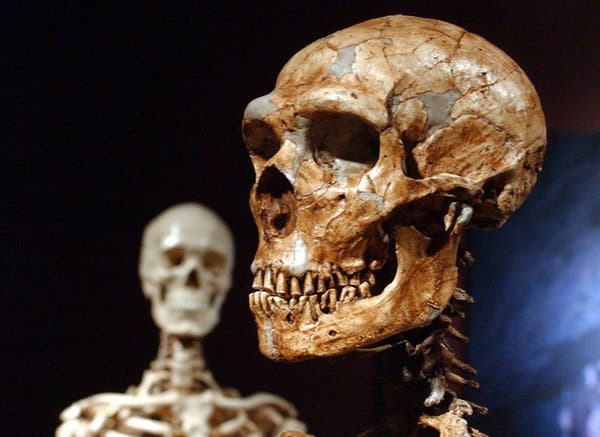One of the challenges by fundamentalist Creationists is that there are 'missing links' which disprove the possibility of the evolution of life. Over the recent history the discoveries of many missing links, and weekly more fossils are being found that build a more complete record of the evilution of life on earth.
The first important discovery was an important link in the evolution of whales. The new discovery was a species of ancient whale that showed the beginnings of the development of a tail fine to propel through water. There are already many species found in the fossil record for the evolution of a land mammal that over recent geologic history to modern whales. Most of these fossils are found in sequence over time in the sediments of the Ancient Indian ocean.
From: New Eocene-Period Whale Unearthed in Egypt | Paleontology | Sci-News.com
New Eocene-Period Whale Unearthed in Egypt
Paleontologists have announced the discovery of a new genus and species of extinct protocetid whale, based on the fossilized remains found in the Western Desert of Egypt. Named Aegicetus gehennae, the ancient animal represents an important step in the evolution of whale locomotion.

An artist’s impression of Basilosaurus isis. Image credit: Pavel Riha / CC BY-SA 3.0.
Protocetidae (protocetids) are a group of semi-aquatic whales known from the middle Eocene epoch of Africa, Asia, North America, and South America.
While living whales use their tails to propel themselves through the water, most protocetids were foot-powered swimmers.
The newly-discovered protocetid, Aegicetus gehennae, was more fully aquatic and less specialized as a foot-powered swimmer than earlier protocetids.
It represents a transitional stage between the foot-powered swimming of early whales and the tail-powered swimming of living whales.
“It is the youngest-known protocetid, dating to around 35 million years ago, and is known from one exceptionally complete skeleton and a partial second specimen, making it among the best-preserved ancient whales,” explained University of Michigan’s Professor Philip Gingerich and colleagues.
Aegicetus gehennae had an estimated body mass of about 900 kg, according to the team.
“Compared with earlier whales, it has a more elongated body and tail, smaller back legs, and lacks a firm connection between the hind legs and the spinal column,” the researchers said.
“These adaptations indicate an animal that was more fully aquatic and less of a foot-powered swimmer than its ancestors.”
Type locality of Aegicetus gehennae in the Wadi Al Hitan World Heritage Site, Egypt. Image credit: Gingerich et al, doi: 10.1371/journal.pone.0225391.
The fossilized bones of two Aegicetus gehennae individuals were collected in 2007 from the Gehannam Formation of Wadi Al Hitan (Valley of Whales), a UNESCO World Heritage Site in the Western Desert of Egypt.
“The body shape of Aegicetus gehennae is similar to that of other ancient whales of its time, such as the famous Basilosaurus,” Professor Gingerich and co-authors said.
“These animals appear to be well-adapted for swimming through undulation of the mid-body and the tail, somewhat as crocodiles swim today.”
The first important discovery was an important link in the evolution of whales. The new discovery was a species of ancient whale that showed the beginnings of the development of a tail fine to propel through water. There are already many species found in the fossil record for the evolution of a land mammal that over recent geologic history to modern whales. Most of these fossils are found in sequence over time in the sediments of the Ancient Indian ocean.
From: New Eocene-Period Whale Unearthed in Egypt | Paleontology | Sci-News.com
New Eocene-Period Whale Unearthed in Egypt
Paleontologists have announced the discovery of a new genus and species of extinct protocetid whale, based on the fossilized remains found in the Western Desert of Egypt. Named Aegicetus gehennae, the ancient animal represents an important step in the evolution of whale locomotion.

An artist’s impression of Basilosaurus isis. Image credit: Pavel Riha / CC BY-SA 3.0.
Protocetidae (protocetids) are a group of semi-aquatic whales known from the middle Eocene epoch of Africa, Asia, North America, and South America.
While living whales use their tails to propel themselves through the water, most protocetids were foot-powered swimmers.
The newly-discovered protocetid, Aegicetus gehennae, was more fully aquatic and less specialized as a foot-powered swimmer than earlier protocetids.
It represents a transitional stage between the foot-powered swimming of early whales and the tail-powered swimming of living whales.
“It is the youngest-known protocetid, dating to around 35 million years ago, and is known from one exceptionally complete skeleton and a partial second specimen, making it among the best-preserved ancient whales,” explained University of Michigan’s Professor Philip Gingerich and colleagues.
Aegicetus gehennae had an estimated body mass of about 900 kg, according to the team.
“Compared with earlier whales, it has a more elongated body and tail, smaller back legs, and lacks a firm connection between the hind legs and the spinal column,” the researchers said.
“These adaptations indicate an animal that was more fully aquatic and less of a foot-powered swimmer than its ancestors.”
Type locality of Aegicetus gehennae in the Wadi Al Hitan World Heritage Site, Egypt. Image credit: Gingerich et al, doi: 10.1371/journal.pone.0225391.
The fossilized bones of two Aegicetus gehennae individuals were collected in 2007 from the Gehannam Formation of Wadi Al Hitan (Valley of Whales), a UNESCO World Heritage Site in the Western Desert of Egypt.
“The body shape of Aegicetus gehennae is similar to that of other ancient whales of its time, such as the famous Basilosaurus,” Professor Gingerich and co-authors said.
“These animals appear to be well-adapted for swimming through undulation of the mid-body and the tail, somewhat as crocodiles swim today.”
Last edited:


